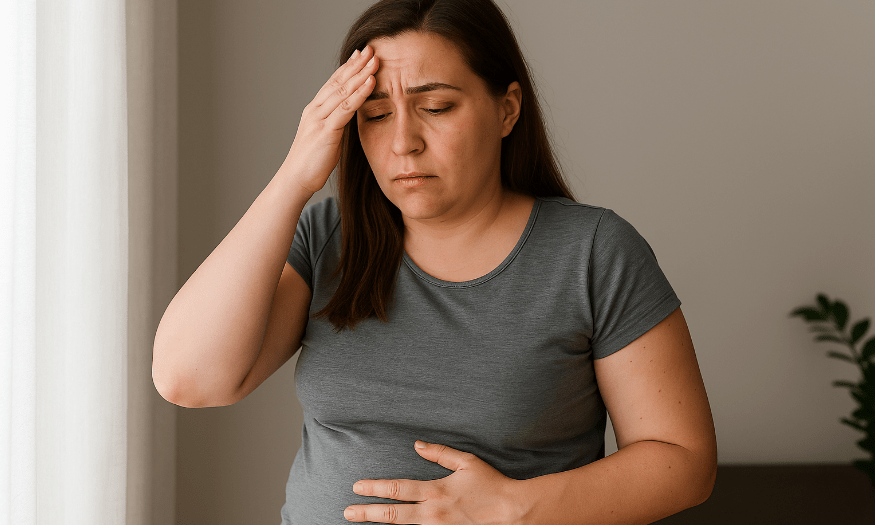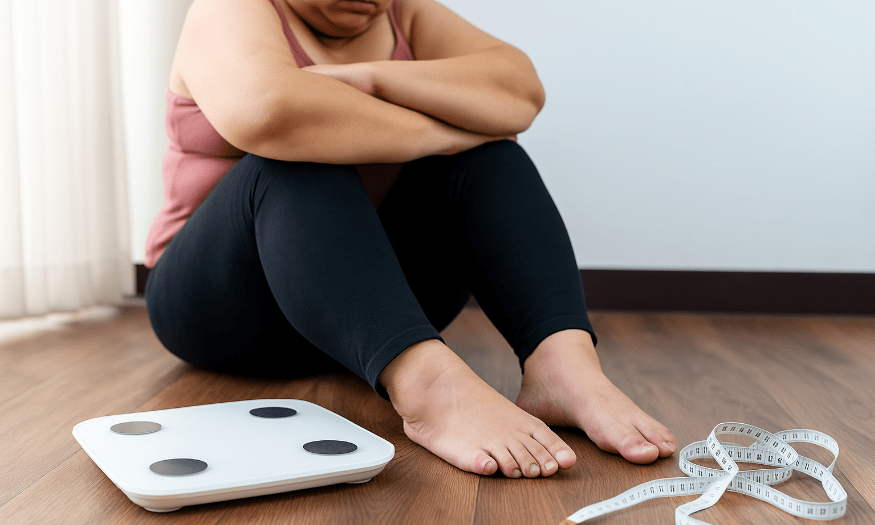When it comes to fat loss, there’s a universal truth we often forget: every woman’s body is different, especially when it comes to how we process food and burn fat. While diet culture tends to treat all bodies the same, a woman’s menstrual cycle can greatly influence how she responds to nutrition, exercise, and weight loss strategies.
Your hormones are constantly shifting throughout the month, meaning what works for your body during one phase of your cycle may not work the same way during another. This is why a “one size fits all” diet approach often misses the mark for women trying to lose weight or achieve fitness goals. Instead, cycle syncing aligning your fitness and diet with the natural rhythm of your menstrual cycle could be a more effective way to manage your health.
Why Does the Menstrual Cycle Affect Fat Loss?
A woman wearing a gray t-shirt stands indoors near a softly lit curtain, gently pressing one hand to her forehead and the other to her lower abdomen. Her eyes are closed and her expression reflects discomfort or fatigue. The setting is calm, with a neutral-colored wall and a small plant in the background. This image visually represents symptoms related to menstrual cycle phases, PCOS, or other hormone-related health conditions.

The menstrual cycle includes four phases, each of which plays a role in how our bodies process food and burn calories. Here’s how each phase impacts fat loss:
Follicular Phase and Menstrual phase
The follicular phase begins on the first day of your period and lasts around 14 days, but this can vary from person to person.
- Estrogen levels rise in this phase so you may feel more energetic, and your workout feels easier. You are also more likely to burn fat during exercise and experience better recovery.
- Diet Tip: This is a great time to focus on cutting refined carbs and sugars, as your body is better able to handle a moderate caloric deficit.
Ovulation
Ovulation is usually around day 14 of your cycle when the ovary releases mature egg. Progesterone and luteinizing hormone rise which can cause a temporary increase in temperature and water retention which can result in a temporary weight gain.
- However, the estrogen level is also high so your body may also be more efficient at fat oxidation, meaning it’s a good time to engage in fat burning exercises or a high intensity workout.
- Diet Tip: Stick to a balanced diet of lean proteins, healthy fats, and moderate carbs, especially as your energy is peaking.
Luteal Phase
The luteal phase (Days 15–28) is characterized by rising progesterone, which can lead to fatigue, cravings, and a reduced ability to burn fat efficiently.
- You may feel a dip in energy and experience an increased appetite, particularly for sugary and salty foods. Focus on getting at least 8 hours of sleep every day during this period.
- Insulin sensitivity decreases in this phase, meaning your body might not handle carbs as well, leading to increased fat storage.
How to Curb those Cravings?
Studies indicate that a diet rich in protein helps to control cravings to some extent. Protein helps stabilise blood sugar level and improve satiety. Food rich in omega 3 fatty acids like salmon can help regulate symptoms like mood swings and menstrual cramps.
Also try to be mindful of finding healthy alternative to curb your cravings. For example, when you find yourself reaching for that ice cream replace it with a frozen yoghurt or fruit sorbet.
What About PCOS and Thyroid Issues?
Women with conditions like PCOS (Polycystic Ovary Syndrome) and thyroid disorders can have further difficulty with weight loss and tracking their menstrual cycle.
- PCOS and Weight Loss
PCOS is a common hormonal disorder that affects women of reproductive age. It can disrupt the menstrual cycle, leading to insulin resistance, irregular periods, and higher levels of androgens (male hormones like testosterone).
- Weight gain and difficulty losing weight are common in women with PCOS because insulin resistance makes it harder to burn fat, especially in the abdominal area.
- Women with PCOS often struggle during the luteal phase when progesterone surges, as higher levels of testosterone can exacerbate cravings and mood swings.
- Diet Tip: Focus on a low glycaemic index diet to reduce insulin spikes and promote fat loss. Strength training and interval training can also help manage insulin levels.
- Thyroid Disorders and Fat Loss
Thyroid conditions, like hypothyroidism, slow down metabolism, making weight loss more difficult. Women with thyroid issues often experience fatigue, depression, and weight gain, especially in the luteal phase.
- If you have an underactive thyroid, your metabolism will be slower, meaning fat loss can be more challenging, regardless of the phase of your menstrual cycle.
- Diet Tip: Make sure you’re getting enough iodine, selenium, and zinc, as they play key roles in thyroid health. Working with a doctor to optimize thyroid function can make fat loss more manageable.

Why “One Diet Doesn’t Fit All” for Women
The key takeaway here is that the hormonal fluctuations throughout the menstrual cycle make it impossible for a universal diet or workout plan to work for every woman. Factors like PCOS, thyroid issues, and even age can further complicate fat loss strategies.
Instead of following a rigid diet, consider cycle syncing, where you tailor your workouts, nutrition, and rest based on your body’s natural rhythms. This way, you can make the most of each phase and work with your body rather than fighting against it.
If you’re struggling to lose weight or find a workout routine that works, it might not be about discipline or willpower. It could be about syncing your efforts with your hormones. Understanding your menstrual cycle, accounting for conditions like PCOS or thyroid imbalances, and adapting your approach to fit each phase can be the key to achieving sustainable fat loss.
Anagha Menon
Junior Nutritionist







